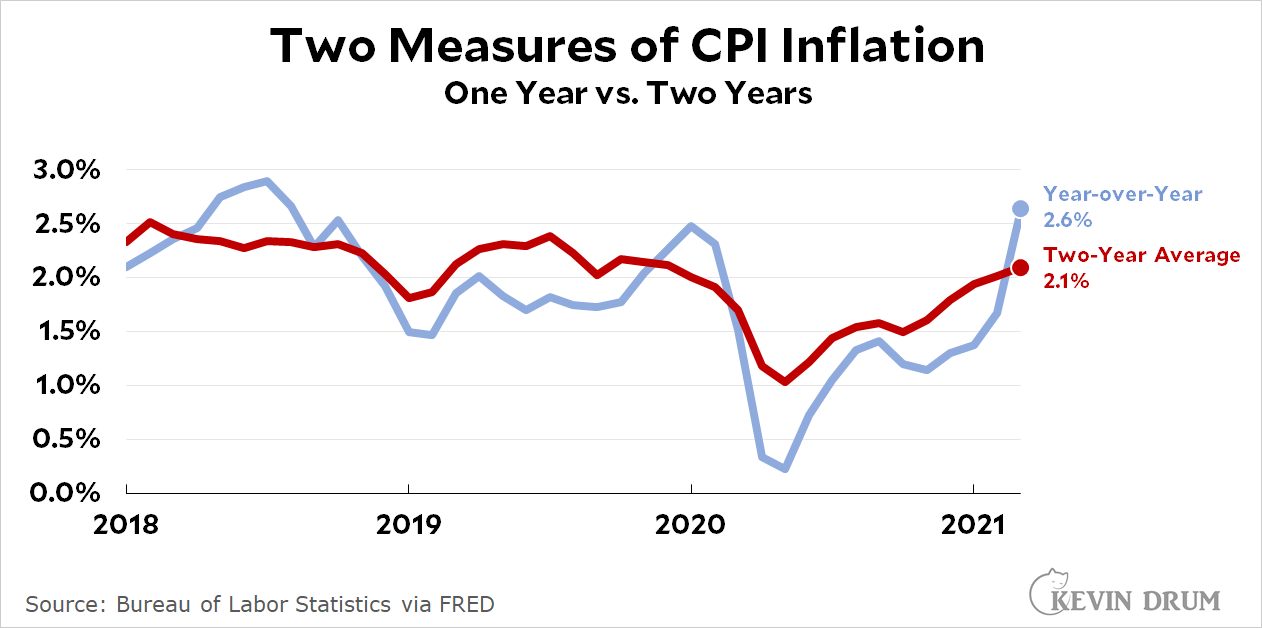You will recall (won't you?) my warning from yesterday that the next few months would bring reports of artificially high inflation rates. Today we got the first one, a headline CPI rate of 2.6% in March, up from 1.7% last month.
This uptick is artificial because it's based on a comparison with March 2020, which was super low. I promised to offer a different view, namely a comparison with March 2019 that's then divided by half to get an annual rate. Here it is:

The two-year average is basically a way of smoothing the data, and there are other ways of doing this. However, this quick-and-dirty approach is enough to let you see what's going on. With the exception of the pandemic dip from last year, inflation has been running at about 2% and it still is. There's nothing to be concerned about.

I note that yesterday, Kai Ryssdal, the hipster anchor of "Marketplace," NPR's daily financial broadcast, issued the exact same warning as you, Mr. Drum: Inflation is going to seem higher than it really is for a while, as the economy returns to "normal."
Kevin claims to know what the "real" inflation rate is, but this is nonsense. You can measure over any period you want (longer than a month, which is how often the BLS reports come out). The month/month (Feb-Mar) inflation rate is 7.4% on an annual basis. Why isn't that the "real" rate? Were prices especially low last month for some reason? Or if you like lower numbers, why not average over the last 3 or 5 years? If you want to predict what inflation will be you will have to predict economic conditions in the future, not play games with the numbers. If you really want to know what prices have been doing, you should probably be looking directly at the CPI or PCE numbers, not the difference over an arbitrary period. Because of the recession and government response there is no reason for prices to return to or remain on the pre-2020 trend in the short term.
Given the CPI figures do not show (aggregate) deflation, why is this month’s figure not “real?” “Catch-up” may have a narrative appeal, but it is still the case that if I bought something last year, I’m spending that much more for it this year, the magnitude of the N-1 vs N-2 comparison aside.
YrY inflation will hit 4+ plus by June. Lets don't be a idiot. Then will fall back to 3% by years end. Total years inflation will probably be 3.2 for 2021, completely knocking out the "Covid disinflation". Unemployment is crashing. It went from "real" 10% in January to probably 8% if you take the PUA add on's and add it in the U-3. It looks like it will be down to 4% by December at this rate. Again, accept what it is and maybe the progtards will grow a brain. You don't have a huge surge in the money supply like that and it not revolving around for years. Its part of the reason why Biden wants as close to a 100% financed infrastructure plan as he can get.
Taxing wealth and upper incomes is a good idea and even necessary for several reasons, but the prices of yachts and fine wines have little effect on total inflation - what raises total inflation, aside from oil price, is mass consumption. If you cause lower-income people to have more money, through sending them checks, raising the minimum wage, making unions more effective, etc. this will cause more demand which is likely to raise prices. But increased prices is how demand is transmitted through the system to increase investment and production. Some inflation is good, as many economists have explained. Raising taxes on the majority of incomes to restrain inflation would be taking away with one hand what is given by the other.
Pingback: Hey NBC, Grocery Prices Are Not “Soaring” – Kevin Drum
https://fortune.com/2021/04/13/lumber-prices-2021-chart-price-of-lumber-futures-short-squeeze-home-sales-cost-april-2021-latest-update/
Lumber up 193%. That seems to be inflationary.